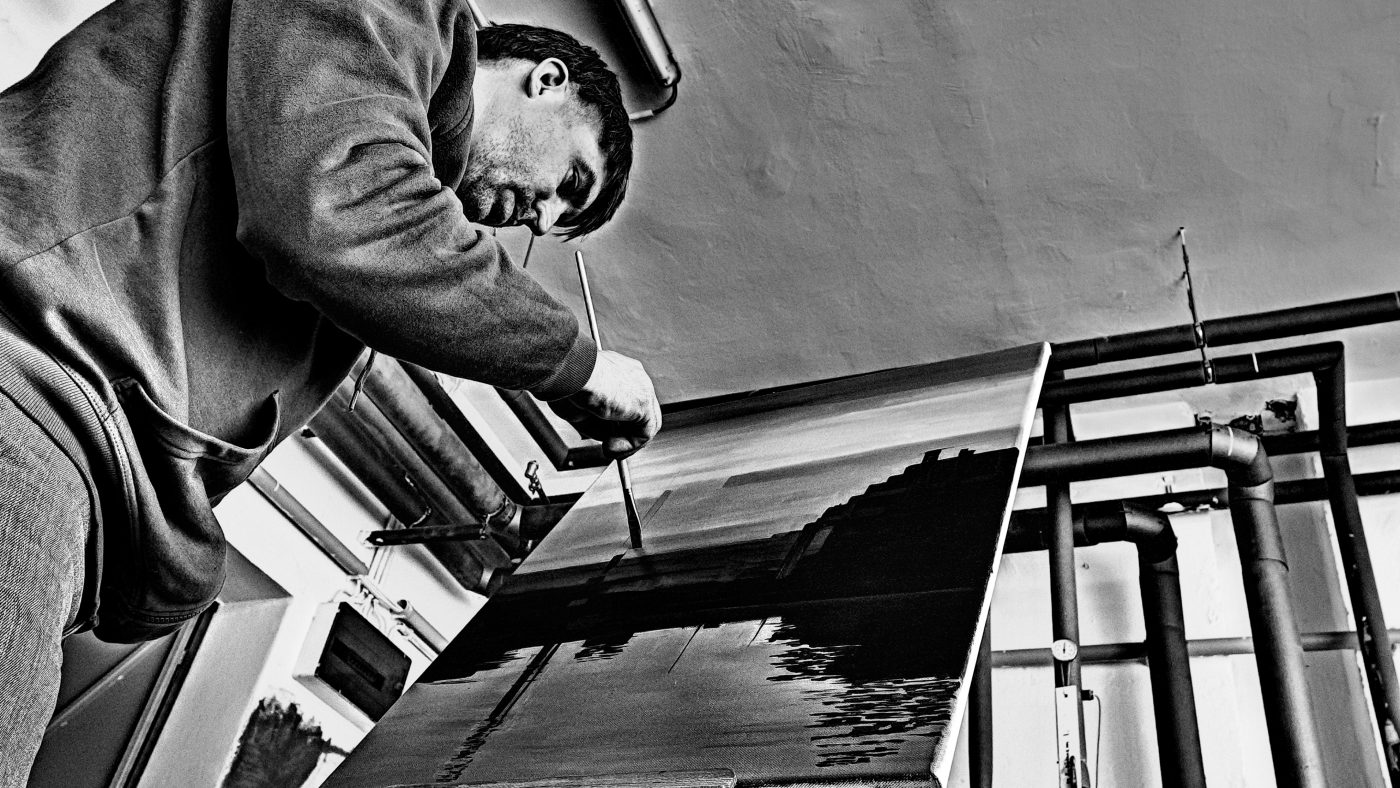The art of Alpár Dóczy (born Hungary, 1974) is composed mostly of avant-garde versatility. He expresses art in various genres and styles, his artistic methods are uniquely individual. He paints, creates ready-made objects, participates in performances, contributes to musical noise productions, acts in films, and most importantly he organizes activities of a community and of fine arts around him, in the artistic group he established.
The artistic activities of Alpár are always motivated by some sort of defiance, something that can be confronted. He never looks for the mundane or follows the ordinary; he always wants to create something new. All this is already reflected in his personality, even his name might appear to be unique to most, as for most people his first name, Alpár, is never heard of before. His family name, Dóczy, refers to his roots in Transylvania and Debrecen; he has several ancestors tying him to the reformed church, who were school founders. He also used to work as a churchwarden, he did this too in a revolting, out of the ordinary way, carrying the flags of reformation and renewal. During the course of his art he always strives to create something novel opposed to the old, while preserving some of the old and carrying on traditions, he wants to also reform them.
Alpár’s life is full of controversies and unusual twists. As a child he often crafted in his father’s workshop, which brought along the love and knowledge of the industrial atmosphere. While the pastor father of his godmother was writing his sermons, he was making drawings in this sacred environment. His mother’s ancestors were poets, painters, bon vivant world citizens, who made a lasting impression on his life. With his family he has strong affinity for Lake Balaton, where he spends a lot of time, also out on open water, sailing. He still practices this passion of his every year in Greece. The horizon out on the sea and the lake are unlimited freedom for him, a path with some insecure float, but with a goal always clearly in the focus.
Alpár acquired his middle school comprehensive exam also in an unusual way and time. He studied art at the Ferenc Medgyessy Grammar School and the Vocational High School of Painting and Graphics in Debrecen. During his years at school he once failed a year in art class – due to administrative reasons. This was also a special, fundamental moment for him, as this was also something he later opposed as a regularly exhibiting artist. In 2020, he graduated from the Werk Academy, Budapest with a degree in Art Management.
Alpár’s life of controversy and restart shows us how he reached the heights of alternative art after so many times when he had to touch the ground. He was always helped in life situations by his happy-go-living, positive, glamorous personality. The notion of „forced creativity”, which he coined himself, describes his personality well.
He is an artist of graphics, paintings and objects. These are avant-garde creations close to Dadaist, constructivist, cubist and surreal trends (Space construct, 2003; Merry Widow, 2014, Giom at harbour, 2015; 59999999, 2016), but some of his works has traces of impressionism (Error, Reflection, 2018). His plain art pieces range on a wide scale including chalk and pencil drawings, linocuts, oil and acrylic paintings. The works are typically abstract, nonfigurative and surreal. He often employs mixed technique by applying prints or objects on his artworks (16 Grindstone, 2011, Doubting Thomas, 2015) or uses the dressmaking patterns of Burda magazine as base (e.g. On the sea shore, 2018). The central figures and motives of his acrylic and oil paintings markedly stand out from the often homogenous backgrounds (The doubter, 2017, Greater Hungary is heaven, 2017). Reality often mixes with fantasy and dreams in his works to form an unexpected or impossible situation (Klukesd SIXII realizes realism when seeing Scortus Perviagilis, 2016). His topical choices are extremely apart, often even within a series, where titles carry substantial roles. His topical choices range from the sacral to the profane (Church tower, and Technoicon, 2003), from the concrete to the abstract (Bloom, and Science, 2003), from images of nature to industrial environment (Reflection 2018 and Sluice gate, 2016).
He uses found objects in his object art, which lose their original function and become ready-made art pieces (Matterless energy cell, 2014, Idol, Choir 2016, Cyanide pollution in Tisza, 2017.) These space-like works reflect the peculiarities, awkwardness of the industrial environment by granting new meaning to objects found in trash. Alpár has painted on car engine hoods, but also carved an ice sculpture which was exhibited as a video art with melt water next to it.
His Self-portrait in gas mask (2003) can be interpreted as his artistic manifest. The gas mask may be a reference to the industrial environment he has been living around since childhood. His self-portrait carries the desires of both to show and to hide, which is synonymous with his special artist character.
His trilingual (Hungarian, English, German) volume was published in 2019, entitled Dóczy Alpár, under the care of the GDR publisher. The study was written by Réka Fazakas, the curator of Műcsarnok / Kunsthalle, Budapest.


